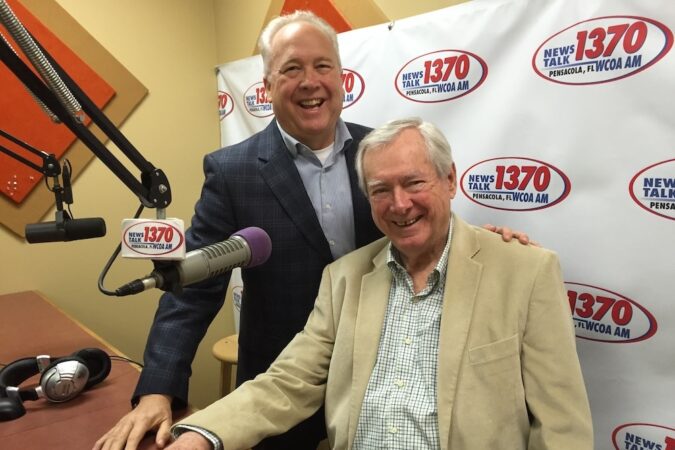
The founder of Rosie O’Grady’s and Seville Quarter, Bob Snow, died Friday at the age of 82 after a fall at his Pensacola home.
Snow successfully transformed downtown Pensacola with the Seville Quarter entertainment complex in the mid-seventies.
What started as Rosie O’Grady’s Good Time Emporium in 1967 later expanded to Apple Annie’s Courtyard, Lili Marlene’s Aviator’s Pub and Restaurant and Phineas Phogg’s Balloon Works.
Snow eventually sold the entertainment complex to his long-time attorney Wilmer Mitchell and his family.
In February 2016, I interviewed Wilmer, who is a great storyteller.
Remembering Bob Snow: A Lawyer’s Front Row Seat to Pensacola History
In Wilmer Mitchell’s voice:
It was around 6:30 one evening in 1967 when Bob Snow walked into my law office on Government Street. I was getting ready to leave – early by his standards, as I would soon learn. “My name is Bob Snow,” he said. “I know who you are,” I replied. That meeting would change both our lives and, ultimately, the face of downtown Pensacola.
I had heard about Snow before he walked into my office. A naval aviation trainee from Minnesota who’d been injured in a car wreck, he was making a name for himself around town with his band, the South Hangar Six. With his distinctive mustache, he looked like a young riverboat gambler. Word was getting around that he wanted to open a saloon downtown – a bold move at a time when every business was either at the mall or headed there.
Snow had managed to secure a lease with an option to buy on an old cigar and tobacco warehouse on East Government Street. His dreams were big, but his pockets were empty. I’ll never forget the day in August when he came to me looking defeated. “I don’t think I’m going to make it,” he told me. The air conditioning contractor had backed out of financing the $3,500 system. When I asked how much he owed so far, his answer surprised me: “Nothing. None.”
I walked him straight across to C&P Bank to see Roger Doyle, a vice president I knew well from my eight years working there. Roger liked Snow’s vision but was hesitant about restaurant and bar loans. Then he surprised us both: “I’m not going to lend you $3,500,” he said. “Because, dummy, you’re going to need some money in the till. I’m going to lend you $5,000.” Snow paid off the entire loan the day after opening.
I was there on opening night, sitting right in the middle next to Dickie Merritt, who was furnishing the beer. The place was packed, with about 400 more people waiting in the street. Snow, ever the showman, orchestrated an unforgettable debut. It started with Tootie Lockhart, a world-class banjo player, and his brother Burt on string bass, playing “Dear One, the World is Waiting for the Sunrise.” Then suddenly, trumpets blared from the top of the stairs. There was Bob, leading a parade of brass, clarinets, and drummers down into the main room. The entire crowd jumped to their feet at 8 PM and didn’t sit down until 2 AM the next morning.
What followed was a remarkable expansion that I helped navigate legally. We started by exercising the option to buy Rosie O’Grady’s. Then came the print shop next door, which had been padlocked by the IRS for two years. The inch-and-a-half of printer’s ink on the floor didn’t deter Bob – nothing did when he had a vision. He transformed that space into Lili Marlene’s, built the End O’ the Alley bar, and added Coppersmith’s Galley restaurant.
One of my favorite stories to tell visitors involves Apple Annie’s. People often compliment us on preserving such a beautiful historic building, but I have to tell them – it was nothing but a chinaberry tree and some dirt when Bob bought it. Everything in that room came from somewhere else. The magnificent doors at the north end? From the Ursuline Convent. Those impressive trusses overhead? Salvaged from the old Casino Beach casino. Bob had an extraordinary talent for finding architectural treasures that nobody else wanted and giving them new life.
Snow went on to create Church Street Station in Orlando, which became another huge success, though his later venture into Las Vegas casinos proved less fortunate. He even spent $280,000 on plans for a New Orleans project at the end of Canal Street Wharf, but walked away when they wouldn’t let him execute his vision exactly as he saw it. That was Bob – always dreaming big and never compromising.
What started as a simple “beer and peanuts” saloon became the catalyst for downtown Pensacola’s revitalization, proving that sometimes the craziest dreams are the ones most worth believing in.
PODCAST:




Charlie & I spent many evenings there at the End Of The Alley. In fact, several years ago that’s the very first place we met. What a special place that was & still is. Hats off to you & everyone who contributed to its success. We are still together. Charlie is now 97 & I (well…) guess that’s not important. In any case your imagination & follow through made a special place come to life and it will always be in our hearts.
Because of Bob Snow’s vision and determination, downtown Pensacola became the place it is today. A visionary who took a chance on developing his dream(s), and thank goodness he did. From dancing waiters to blaring clarinets, he was truly the showman. Thanks Bob, you made my early years in Pensacola one’s to remember and cherish. Rest in peace my friend, you deserve it.